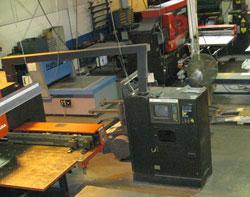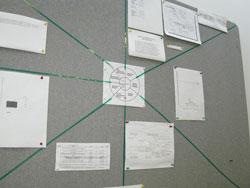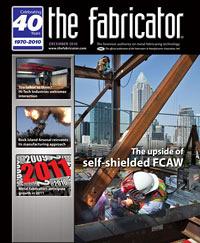Senior Editor
- FMA
- The Fabricator
- FABTECH
- Canadian Metalworking
Categories
- Additive Manufacturing
- Aluminum Welding
- Arc Welding
- Assembly and Joining
- Automation and Robotics
- Bending and Forming
- Consumables
- Cutting and Weld Prep
- Electric Vehicles
- En Español
- Finishing
- Hydroforming
- Laser Cutting
- Laser Welding
- Machining
- Manufacturing Software
- Materials Handling
- Metals/Materials
- Oxyfuel Cutting
- Plasma Cutting
- Power Tools
- Punching and Other Holemaking
- Roll Forming
- Safety
- Sawing
- Shearing
- Shop Management
- Testing and Measuring
- Tube and Pipe Fabrication
- Tube and Pipe Production
- Waterjet Cutting
Industry Directory
Webcasts
Podcasts
FAB 40
Advertise
Subscribe
Account Login
Search
Fabricating to the drumbeat
Fab shop grows with improvement methodologies, including drum-buffer-rope
- By Tim Heston
- December 2, 2010
- Article
- Shop Management

Figure 1: The shop floor at C.O.W. Industries has minimal work-in-process between its laser, punch press, press brakes, and other equipment. The shop is clean, and work flows steadily to downstream processes. It wasn’t always this way.
Gary Foreman remembers tripping hazards. On the shop floor of C.O.W. Industries, you couldn’t see much of, well, the actual floor. Metal blanks and half-completed parts lay everywhere.
“I wish I had taken a picture back then,” he said. “It was difficult to walk from one end of the shop to the other. We were constantly looking for parts. When we lost them, we’d remanufacture them, and then find the parts we originally lost. It was chaotic.”
This was reality for the Columbus, Ohio, job shop in the 1980s, when the company operated with six- to eight-week lead-times. Even then the shop delivered on time only 65 to 75 percent of the time.
The reality is much different today. All deliveries are made within 15 business days of order placement, and most are met within seven days. The company’s on-time delivery rate is more than 95 percent.
“Once a job hits the floor and is released, it’s our goal to have it ready to ship within three business days,” said Foreman, vice president of manufacturing.
A Bumpy Road
Company origins go back to 1911, when the founders launched a welding supply distributorship called Central Ohio Welding (hence the company’s distinctive acronym). In the 1960s, one of the distributorship’s salespeople heard that Western Electric, then the manufacturing arm of AT&T, was searching for a sheet metal fabricator. The distributorship soon spun off its C.O.W. Industries fabrication subsidiary and moved into a facility south of downtown Columbus.
And there it remains, looking much the same on the outside as it did decades ago. The inside, though, is transformed (see Figure 1). The shop floor is clean, and inventory is minimal.
This isn’t a story of how great lean manufacturing is, or the theory of constraints, or any other continuous improvement strategy. It’s a story about how the shop cherry-picked the elements from various techniques and adapted them to its high-mix, low-volume environment.
The story also doesn’t prove that after implementing continuous improvement everything will be just peachy. In the late 1990s and early 2000s, managers began to seriously rethink shop floor layout. They rearranged machines to streamline part flow and increase efficiency. The shop, which had only wet painting capability, added a powder coating line to satisfy some of the environmental requirements one telecom customer demanded. Soon after, though, the bottom fell out of the telecom business. Large contracts ended, and to survive the company had to shed much of its work force, from more than 80 to eight. You read right—only eight. The company’s survival was at stake.
Note that the bottom fell out after managers started their continuous improvement initiatives. No matter how efficient, a manufacturer needs work coming in the door to survive.

Figure 4: This laser alignment tool, inside the company’s vertical machining center, automates the tool-setting process.
The Need to Diversify
Managers knew they needed to diversify the customer base, but they also knew how easy it is for the shop sales effort to fall back into familiar territory. “We hooked on to one really good customer, and we realized [the situation] was almost a spitting image of being so tight with the telecom business,” Foreman said. “We knew we had to get off that road.” So managers actively pursued diversification, gradually driving revenue up annually by the middle of the decade.
Did all this continuous improvement and customer diversification guard against the latest whopper of a downturn? Not really. The Great Recession left few untouched, and shop revenue plunged to $2 million. This year Foreman expects the shop’s 30 employees to fabricate about $3 million worth of work.
The work comes from close to 400 customers from various sectors. More than a dozen give C.O.W. steady, repeat work. Employees fabricate, among other things, enclosures for electric utilities; weightlifting equipment for a customer who sells to high schools and colleges; speaker brackets for professional audio setups; a recoil reduction system for a 50-caliber machine gun on a Bradley tank; and a sheet metal component for the front of a fire truck.
After 22 months of red ink, C.O.W finally edged into profitability this summer. Though if someone unfamiliar with inventory control were to walk onto the 80,000-square-foot floor, he might think the company is about to run out of work. A bit of aluminum and carbon steel sits on a few racks at the shop’s front end; a few short stacks sit by the primary cutting centers; and limited work-in-process (WIP) sits by the brakes, welding, grinding, painting, and assembly. But after a while that person would notice that the work comes in a steady stream—and always moves. If work doesn’t move, there’s a problem.
Inventory Management
Several areas of the shop exemplify how managers chose nuggets from different improvement strategies. The inventory—raw, WIP, and finished—reflects lessons learned from Speed to Market, a job shop improvement strategy touted by Vincent Bozzone, a consultant who runs Delta Dynamics of Bloomfield Hills, Mich.
A portion of Bozzone’s strategy involves “keeping the right kinds of inventory in stock,” Foreman said. The strategy describes how to “define your most common materials, and work with your suppliers to set up consignment or quick-shipment programs. At this point we’ve worked with vendors and suppliers about bringing in material almost on a daily basis.”
C.O.W. has inventory programs for both raw and finished goods. For example, a stack of aluminum is received on consignment, and the metal supplier sends a bill only after C.O.W. sends that sheet into production. For finished goods, the company has a warehouse kanban replenishment system set up with customers (see Figure 2); it’s a demand-pull system done job shop-style.
Diverse Capabilities
Metal moves through the shop’s Amada punch presses, 4-kW laser, and press brakes; hardware insertion; then welding, grinding, painting, and assembly. Managers have tweaked machine placement over the years. In the 1990s, for instance, the shop began to work with Dr. Shahrukh Irani, associate professor at The Ohio State University’s Department of Integrated Systems Engineering. A group of his industrial engineering students examined the job shop’s work load and, using analytical software called PFAST (Production Flow Analysis and Simplification Toolkit), developed by Irani, identified literally thousands of different routings that various jobs could take. From that they determined the best way to lay out equipment to avoid unnecessary travel.
The company also has several machining centers. Foreman held a part fabricated regularly for the Battelle Institute, an R&D organization based in Columbus (see Figure 3). The plate is cut on the Amada laser and then taken to the Haas vertical machining center, which mills pockets and edge contours into the plate.
The shop invested in a Renishaw laser alignment tool that sits inside the machining center and essentially automates the tool-setting process (see Figure 4 ). Instead of spending 30 or 40 minutes manually offsetting cutting tools, the operator inserts the tools, “and gets a cup of coffee,” Foreman said. “When he comes back, it’s finished and ready to go.”

Figure 5: A welder joins a large component that helps stabilize a fire truck when its ladder is extended.
About the only processes the company doesn’t do in-house are screen printing and plating. Still, even outsourced parts are turned around extremely quickly. He pointed to a series of panels prepped for painting. The repeat order was processed through laser cutting, deburring on a Timesaver, sent out for plating, then back to C.O.W. for hardware insertion on Friday. “Today’s Monday. We’ll have these painted by tomorrow, and then we’ll be ready to ship,” Foreman said.
The TOC Rope
Managers carefully monitor inventory levels and base the amount of WIP buffers they need on one application of the theory of constraints. Called drum-buffer-rope, the drum of their operation is the weakest link, or the bottleneck. It beats the cycle time of the entire operation. The buffer is the work-in-process (technically, the time it takes to process the WIP) to protect against unforeseen variability, so that workers never run out of parts, and that drum never stops beating. The rope is the work release schedule based on due dates.
For C.O.W., the drum—the principal bottleneck—often is the welding area, so managers never release jobs until the buffer at the drum reaches a certain level. At that point orders are released through cutting and bending, and then they arrive at the welding cell just in time to maintain that minimal WIP buffer. If shop personnel see the buffer rising at the welding area, employees are deployed to help transport and fixture material for welding, relieving the choke point.
The choke point also is where some design for manufacturability comes into play. Foreman pointed to a small tab on a heavy welded component, eventually to be installed on a fire truck to help stabilize it when the ladder is extended (see Figure 5 and Figure 6). That small tab simplifies and speeds fixturing, so the welder doesn’t have to measure components for every setup. He just slides the tabs into the slots, applies fixtures, and he’s good to go.
Before the company implemented the theory of constraints (TOC), a job would come in the door and be released to the production manager, who would keep it for a few days until he could find where he could squeeze the job in. Material came in, was sheared, and then sat in front of the turret presses for days. It would then go to the press brake and sit again for days before it was finally bent. Then it would be sent to outside vendors, who sometimes took two or three weeks to return the work. It would finally be assembled, packed, and then sit on the loading dock for days before finally being shipped to the customer.
Today, of course, is different.
The job release schedule is synchronized with material deliveries, and outside vendors turn around product within a day or so. The shop focuses on the choke point—the drum beat—to optimize throughput. For instance, in the 1990s the shop received a large order from Lucent Technologies. “We could only do 500 to 700 of these parts every six to eight weeks. But once we started implementing elements of TOC, we were about to produce 1,500 per week.”
Such a dramatic increase in throughput came about by identifying the choke point and finding a creative way to relieve it. In this case, the press brakes were the bottleneck. Operators could bend only so many an hour. But cutting with a turret punch and bending with a press brake aren’t the only ways to manufacture a formed sheet metal part.
Managers then looked at the company’s stamping press and had a revelation. What if they could machine a blanking die to stamp out the part profile, machine a forming die to stamp the bends, and run a portion of the work through a stamping press? The company also worked with its plating supplier to pack the finished components as well. “So when the parts came back here, we didn’t even have to pack them,” Foreman said.
About Character
Adjacent to the front office is a classroom (see Figure 7), and on the wall are various education projects, some directly related to manufacturing, some not. One outlines the basics of the plan-do-check-act methodology. Next to this is the Ishikawa fishbone diagram of root cause analysis. Another shows some basics behind TQM, or total quality management. Next to these are notices for some starkly different subjects—stress management, writing wills, and other life skills.

Figure 7: This board in the company classroom illustrates fundamentals of the plan-do-check-act methodology.
A bit of Foreman’s background reveals, at least in part, why this classroom exists and how the company goes about hiring and training its work force. During his junior and senior years in high school he went through the machines trades program at Easton Career Center in nearby Groveport. A year later the high school graduate, all of 19, walked onto the shop floor at C.O.W., hired as a machinist in 1985. “The machine shop had an old lathe with about 11 belts on it,” he recalled. Every time he needed to change speeds, he had to pry open the thing and change the belt configuration. “I was wondering what I had gotten myself into! But as I hung around longer, I really enjoyed the fabrication end of things. I had always been mechanically inclined, and press brakes fascinated me.”
He worked the second shift and within a year became second-shift supervisor. In 1995 he became continuous improvement manager and, finally, vice president of manufacturing. A man hired as a teenager with no sheet metal experience, Foreman is slated to become president once the company owner retires within the next few years.
This is one reason that it’s no surprise that C.O.W. hires for character, not necessarily experience—a strategy that has worked well as experienced labor gets difficult to find, even during tough economic times. The company outsources its hiring to another firm that specializes in behavioral analysis and testing. Managers bring new employees in for a four-month trial; if they pass muster they are then put on the payroll as permanent employees.
“I’m willing to train,” he said, explaining that most employees are cross trained on various processes; this is critical if the shop needs to relieve bottlenecks. Employees must be flexible to go where they’re needed most.
“I hire for behavior and character,” he added. The outside firm “is hitting a batting average a little more than 600 for us. That’s really good.”
Foreman boiled down the company’s business strategy to two elements: having the right employees and the right customer mix. “You need to diversify your business, and you need to have the right people on the bus, sitting in the right seats.”
For C.O.W., the bus has driven over some bumpy roads, but the engine’s still running, driving ahead toward growth.
About the Author

Tim Heston
2135 Point Blvd
Elgin, IL 60123
815-381-1314
Tim Heston, The Fabricator's senior editor, has covered the metal fabrication industry since 1998, starting his career at the American Welding Society's Welding Journal. Since then he has covered the full range of metal fabrication processes, from stamping, bending, and cutting to grinding and polishing. He joined The Fabricator's staff in October 2007.
Related Companies
subscribe now

The Fabricator is North America's leading magazine for the metal forming and fabricating industry. The magazine delivers the news, technical articles, and case histories that enable fabricators to do their jobs more efficiently. The Fabricator has served the industry since 1970.
start your free subscription- Stay connected from anywhere

Easily access valuable industry resources now with full access to the digital edition of The Fabricator.

Easily access valuable industry resources now with full access to the digital edition of The Welder.

Easily access valuable industry resources now with full access to the digital edition of The Tube and Pipe Journal.
- Podcasting
- Podcast:
- The Fabricator Podcast
- Published:
- 04/16/2024
- Running Time:
- 63:29
In this episode of The Fabricator Podcast, Caleb Chamberlain, co-founder and CEO of OSH Cut, discusses his company’s...
- Trending Articles
AI, machine learning, and the future of metal fabrication

Employee ownership: The best way to ensure engagement

Steel industry reacts to Nucor’s new weekly published HRC price

Dynamic Metal blossoms with each passing year

Metal fabrication management: A guide for new supervisors

- Industry Events
16th Annual Safety Conference
- April 30 - May 1, 2024
- Elgin,
Pipe and Tube Conference
- May 21 - 22, 2024
- Omaha, NE
World-Class Roll Forming Workshop
- June 5 - 6, 2024
- Louisville, KY
Advanced Laser Application Workshop
- June 25 - 27, 2024
- Novi, MI


























